Did you know that sourdough starters aren’t just for making bread? You can can use a starter for an unlimited amount of recipes, including pancakes, flatbreads, pie crusts, biscuits, cookies, and so much more! What a new and beautiful (not to mention tasty!) world it is to have sourdough starter in your kitchen. Get the beginner sourdough starter recipe, instructions for how to care for it, and so much more below!
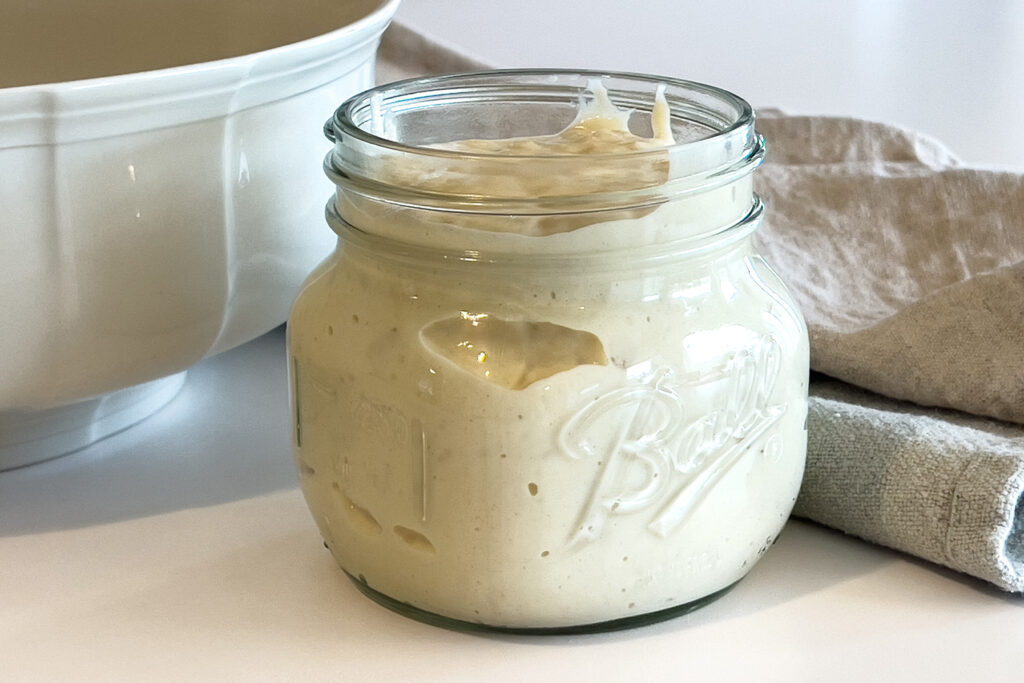
What is a sourdough starter?
Sourdough starter is made up of just two ingredients: flour and water. When you mix these ingredients in a certain way (covered below), it creates an environment for a wild colony of yeasts to grow and thrive. Because the wild yeasts ferment grains, it causes baked goods to rise. This is because the fermentation process gives off carbon dioxide, which makes those beautiful air bubbles in a good sourdough bread.
Sourdough is the original leavening that has been used for thousands of years. The yeasts in the starter are living organisms that require regular feedings of flour and water to stay alive and thrive. Instructions for creating and feeding your starter are below.
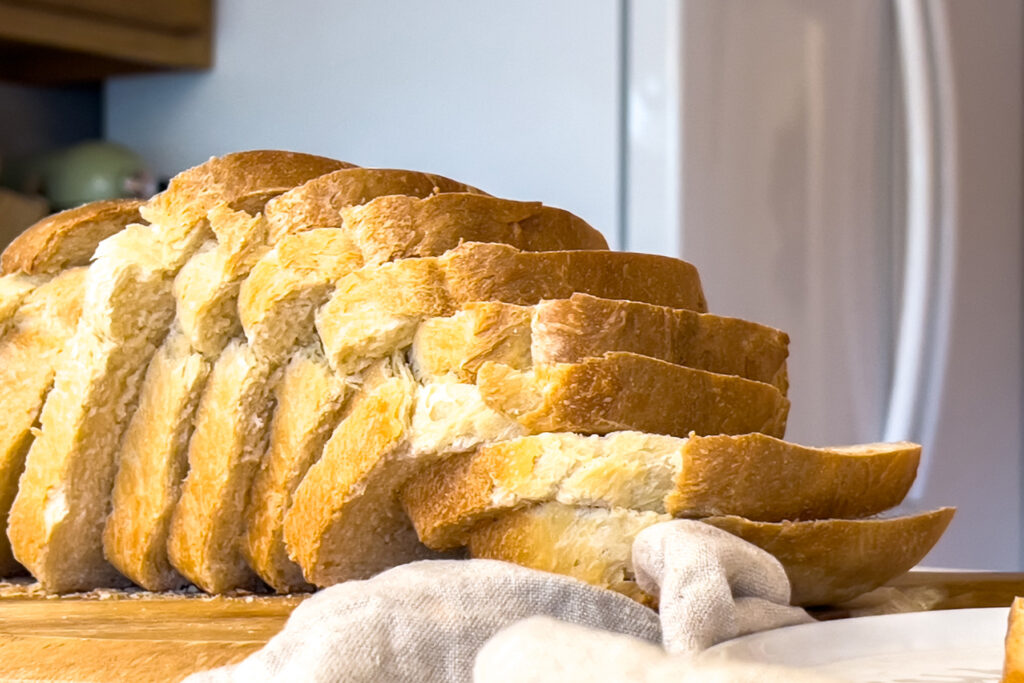
Benefits of Sourdough
The colony of yeasts in a sourdough starter are praised for their ability to make delicious bread that is healthier for your gut. It is also much easier to digest because the grains (flours) are partially broken down, which leaves less work for your digestive system to do!
Additionally, many people who have a gluten intolerance (NOT an allergy or celiac) find that they can tolerate sourdough bread because the gluten content is much lower than other breads. This is not medical advice; it is just an experience that many people have. Of course, always contact your doctor or nutritionist for any medical or nutritional advice.
In addition to these benefits, sourdough bread contains a variety of natural vitamins and minerals. Most contain a source of these essentials: calcium, magnesium, folate, potassium, niacin, antioxidants, and more!
The benefits of sourdough include but are not limited to:
- The grains are partially broken down, making them easily digestible.
- It is the traditional way to leaven breads and baked goods.
- The gluten content is lower than many other breads.
- It has a lower glycemic index compared to other options.
What can you do with a sourdough starter?
You can use a sourdough starter in almost any type of recipe that would call for flour or yeast. This includes cakes, breads, pies, pizza crusts, cookies, and the best cinnamon rolls; the possibilities are literally endless.
Find all of my sourdough recipes here, and subscribe to my email newsletter to be alerted when new recipes are released!
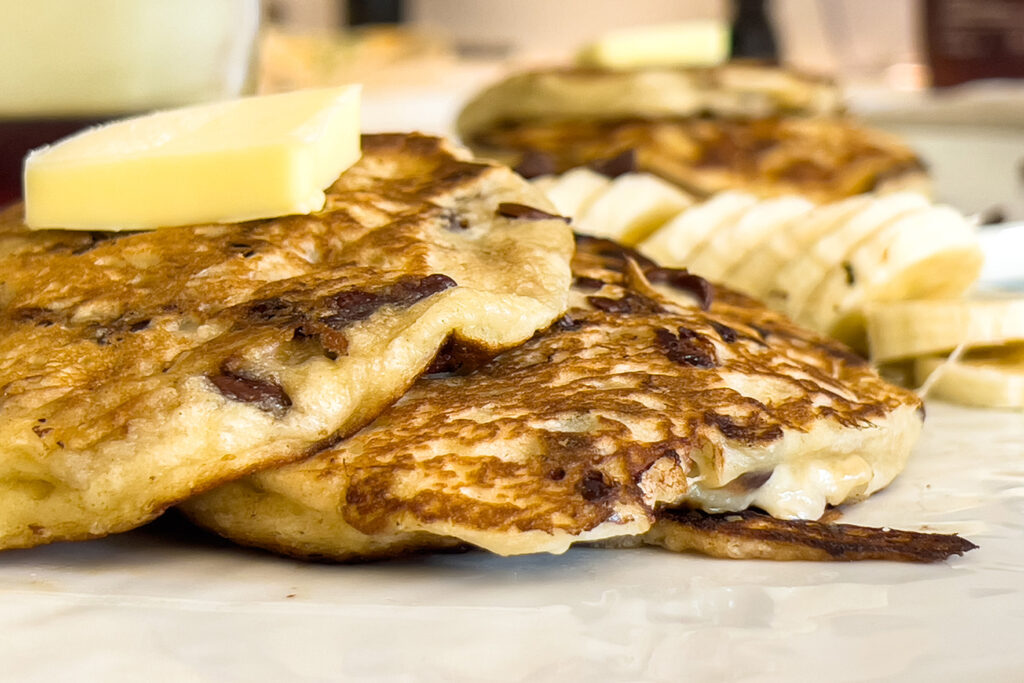
Why is sourdough better?
Instant yeast packets are a (dare I say…subpar?) imitation of the wild yeasts found in sourdough. Unlike sourdough, instant yeast products are not long-fermented, and therefore lack all of the digestive, low gluten, low glycemic benefits that traditional sourdough offers.
Sourdough starter actually used to just be called “yeast” or “leaven”, because it was the traditional method for making baked goods. It has only been recently (the last less than 100 years) that our society has traded the health benefits of sourdough for the convince of fast-rising yeast packets, and instant yeast has became the norm.
Un-commercialized, wild, living yeast is what has been used for thousands of years to make grains digestible and healthy. Our modern-day substitutes just cannot compete, which is why there is a mass return to the traditional sourdough methods for making bread today. Before commercialized dry yeast was invented in the 1940s, all bread was sourdough bread.
Sourdough is better for your gut, richer in vitamins and minerals, and as a bonus it tastes so much better than anything else!
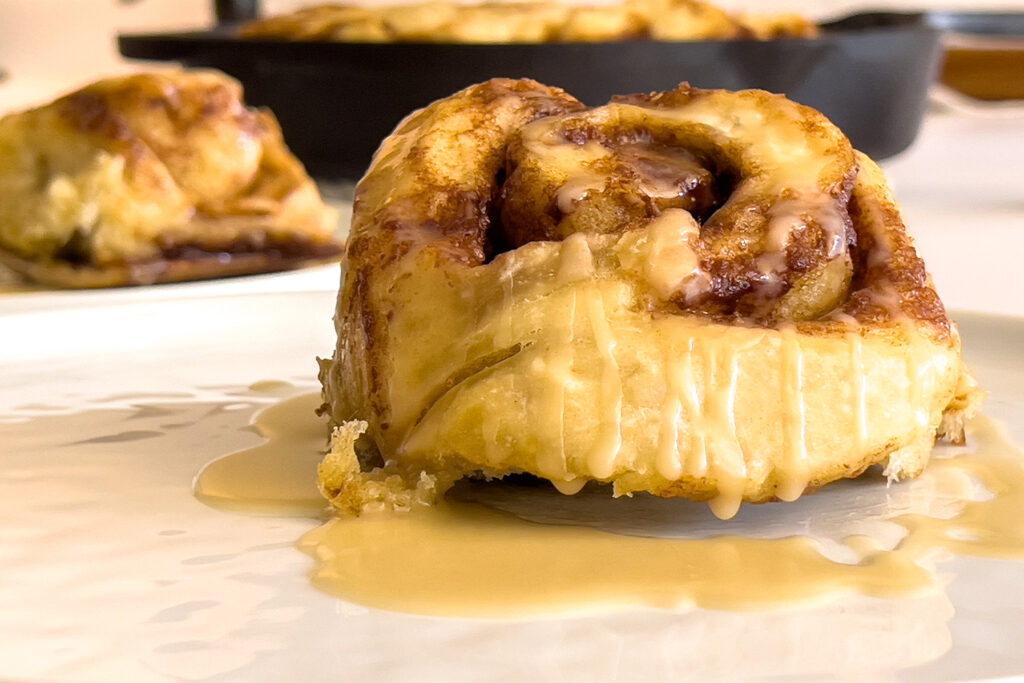
The Process of How to Make It
Here is the easiest sourdough starter recipe, made from scratch! You could be baking your first loaf of bread in less than ten days!
Supplies
- Glass Jar: The best container that I have found for making a sourdough starter is this Anchor Hocking jar, because it has a very wide mouth that is easy to fit measuring cups into, and it also isn’t airtight which is exactly what you want.
- Measuring Cup
- Spatula
- Any Bowl Cover (only if you don’t use the jar linked to above): If your glass jar does not come with a non-airtight lid, then you can use a tea towel or stretchy bowl cover to cover it loosely.
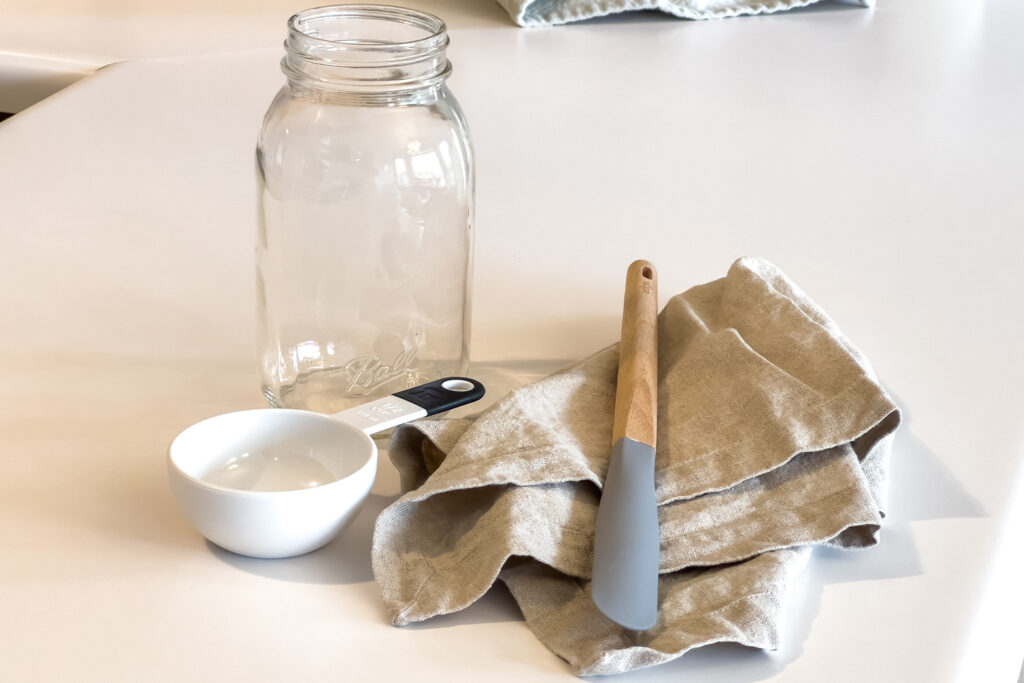
Ingredients
- Unbleached Flour: Unbleached all-purpose flour works perfectly, but you can use whole wheat, einkorn, pumpernickel, or any other preferred wheat flour. You can change the type of flour that you are using at any time, so there’s no pressure on deciding which one to start with.
- Purified Water: It’s best to avoid tap water when possible, as most tap water is treated with additives that can affect the health of your starter.
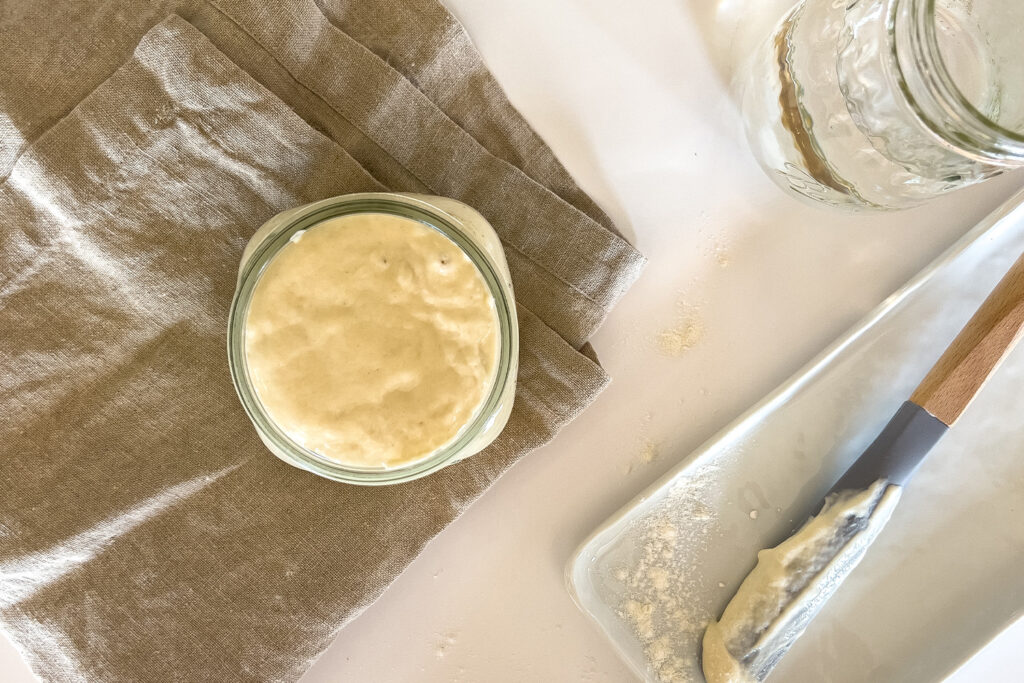
Steps
DAY 1:
In your glass jar, combine 1 cup of flour with 1/2 cup of filtered water. Stir well with your spatula. Make sure to scrape the sides and stir until no dry flour remains. Cover loosely with the lid or a tea towel (nothing airtight) and let sit undisturbed at room temperature for about 24 hours.
DAY 2:
After 24 hours, reserve 1/2 cup of the mixture, and discard what is remaining (see below for what you can do with this discard). Place the reserved 1/2 cup of the mixture back into your jar, and add 1 cup flour and 1/2 cup water. Stir until thoroughly combined, and cover loosely again just like yesterday. Allow to sit about 24 hours.
DAYS 3-7:
Repeat the steps from day two every day for the rest of the week. Over the course of the week, you should start to see some activity such as bubbling, rising and falling, and a bit of a sweet and sour smell from your sourdough starter (like the smell of a sourdough bread loaf).
DAY 8 (AND EVERY DAY AFTER):
Congratulations! You should now have an active sourdough starter. To keep this starter alive, you’ll need to feed it daily (following the steps from “Day 2” above) if you’re keeping it on the counter, or you can feed it once every week or two if you’re storing it in the fridge. The warmer the environment, the more often it needs to be fed because the yeasts are more active in warmth.
You can also play around with different ratios of flour to water. My personal preference (and the way I feed my starter regularly now) is to combine 1/2 cup sourdough starter + 1 1/8 cup flour + 3/4 cup water. This creates a stiffer starter which in turn makes it easier to work with when baking. It also allows you to use 1 cup of starter in a recipe, and leaves behind roughly 1/2 cup behind so that it is ready to be fed again.
For an in-depth view on why the hydration of sourdough matters, visit Wild N Free Farms.
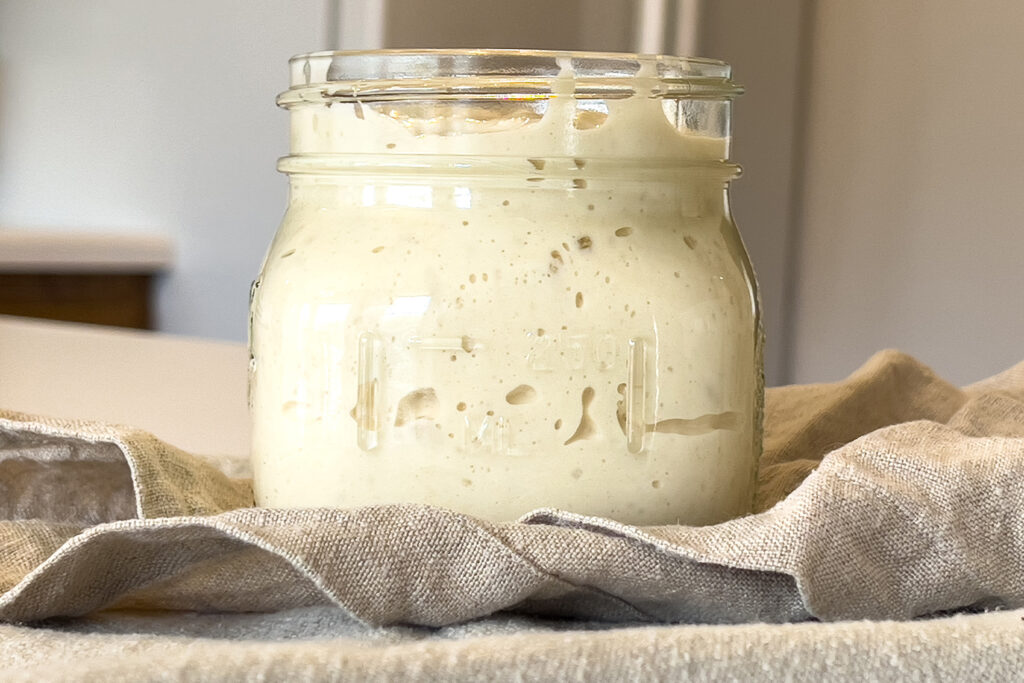
How do I know if my starter is ready to use?
To know that your starter is mature enough to bake with, there are a few indicators to look for. First, active starters are bubbly and typically rise and fall. You will see it bubble up over the course of several hours, and then it will fall back down again.
Many people rely on the “float test” for making sure their starter is ready to bake with. You can spoon a small amount of starter into a cup of water. If it floats, then it is considered ready to use, and if it sinks, then it is not ready yet. However, I will say that even if your starter doesn’t pass the float test, it may still make a delicious loaf of bread. The temperature of the water, type of flour used, and other environmental factors beyond your control can all affect the float test.
As long as your starter is bubbling (rising and falling), and it has that classic sourdough smell, then it is ready to use. There’s really no risk in giving it a try if you’re unsure, just go for it! If the bread is a flop, you can cut it up and use it as croutons or in a casserole. Nobody will know the difference!
Do I actually have to discard when making sourdough?
You may be wondering why nearly every sourdough starter recipe says to discard part of it each day. Explained simply, the yeast in sourdough starters have to eat their own weight in flour each day to stay alive. Therefore, the more sourdough starter you have, the more flour you are required to feed it. So if you don’t discard (or use up) part of your mixture before feeding it each day, than you would have to keep feeding it exponentially more and more flour each day, and that just isn’t possible or sustainable. See below for what to do with the discard so that it never goes to waste.
What can I do with the discard?
For the first couple of days if you’re just beginning to make your starter, your mixture isn’t really a sourdough starter yet, as the yeasts haven’t had time to grow and become active. Essentially, your discard at the beginning is truly just flour and water. You can use it in a recipe that calls for flour and water if you’d like. But since the results could be varied, it may be easiest at first to use it in your compost or feed it to your chickens.
Once the starter becomes more bubbly and active, it can be used in recipes that call for sourdough discard. Or, you can put it in a separate jar in the fridge, and save it for a day when you plan to use sourdough discard in a recipe. You don’t have to use it up right away!

Can I store my sourdough starter in the fridge?
You can absolutely store it in the fridge! If you do, you will only need to feed it once a week or two.
To feed a refrigerated starter, pull it out of the fridge and then feed it as usual. Make sure to leave it at room temperature for at least 8-12 hours after feeding before refrigerating it again if your only goal was to feed it and not use it.
If you’re going to use it in a recipe where the starter is the only leavening agent (like sourdough bread), you may need to pull it out a day or two before you plan to use it, so that you have time to get two feedings in before making the recipe. Sometimes it needs two feedings to get it active and happy again.
Can I freeze my sourdough starter?
Yes, you can! Freezing your starter halts the growth of the yeast. This means that you do not have to feed the starter while it is being stored in the freezer. So when life gets crazy, or you’re going on an extended trip (a month or longer), just freeze your starter for later. No need to worry about losing all of your hard work.
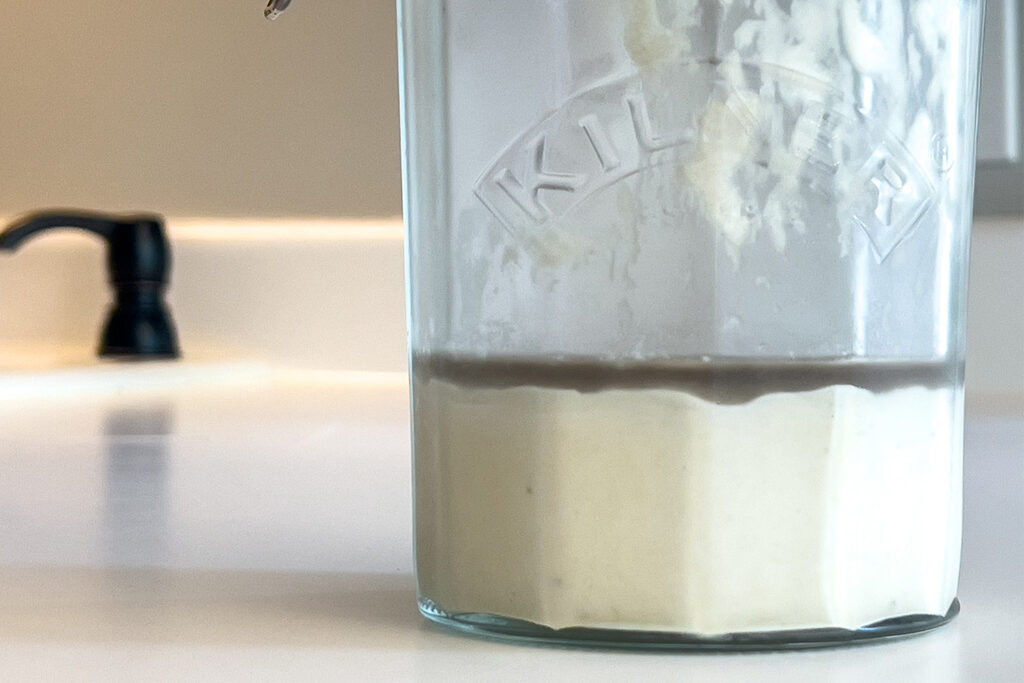
There’s a layer of gray or black liquid on top of my starter! Help!
Not to worry. This dark liquid that sometimes forms on top of the sourdough starter is called hooch. It is a byproduct the yeasts give off when they have run out of food (flour) and are very hungry! For best results, you’ll want to pour as much of the hooch off as you can before feeding your starter as usual. Some people stir it in, but it tends to add a strong and bitter taste to the starter that takes several feedings to go away. Your starter will bounce back in no time!
Can I turn a regular recipe into a sourdough recipe?
Absolutely! This may take some trial and error, but here are a few steps to convert your favorite recipes into sourdough recipes. Don’t be afraid to give it a try!
- Omit any instant yeast from the recipe. You will need to allow your recipe to proof longer since sourdough starter is slower acting than instant dry yeast.
- Use 1 cup of sourdough starter in place of 1 cup flour and 1 cup of the liquid component. Or equal parts if that is more applicable.
- For the long-fermented sourdough health benefits: Mix the ingredients in the recipe together in advance to give the yeasts time to work. If the ingredients in the recipe are safe at room temperature, than allow the mixed dough to sit at room temperature overnight. If the ingredients require refrigeration, then allow the dough to ferment in the fridge for 2-3 days for maximum health benefits.
Example of a honey bread recipe that’s turned into sourdough honey bread (example only, not an official recipe):
Original recipe ingredients:
- 1 pkg. dry active yeast
- 1 1/2 cups warm water
- 1/4 cup honey
- 4 cups flour
- 1 tsp. salt
Modified for sourdough recipe ingredients:
- 1 cup sourdough starter
- 1/2 cup water
- 1/4 cup honey
- 3 cups flour
- 1 tsp. salt

I know someone that already has a sourdough starter. Can I just make mine from theirs?
Absolutely! Sourdough starters are very adaptive. You can take 1/4-1/2 cup of their mature starter, add your 1 1/8 cup flour and 3/4 cup water, and you’ve got your very own starter.
There’s so much charm in sharing a sourdough starter. It used to be passed down for generations since sourdough starters get stronger and more resilient with age. However, there’s also a sense of accomplishment in making your own from scratch. No matter how you get your starter, you should be proud that you’re reconnecting with traditional methods that have been used for thousands of years. There’s nothing like it!
A Valuable Tip: Always keep a backup starter in your fridge.
Several months after I made my sourdough starter, it developed an issue. Some other type of bacteria had gotten into it, and it was molding and turning orange. It had a putrid smell. Unfortunately, after may attempts to try to revive it, it was beyond recovery and I had to throw it out.
BUT THEN I remembered…I had some of my starter discard in a container in the fridge that I had put in there a few weeks before! I pulled it out, fed it, watched it for well over a week feeding it daily, and it was clean! No mold!
Always keep a backup starter (just some discard from one of your feedings) in the fridge. It can almost always be revived even if it has been there for an extended period of time. It’s so much easier to revive a starter than to make one from scratch, and it retains that maturity and resiliency that you took precious time to build up.
Anything can happen to your starter at any time, so save yourself the heart attack and keep that backup!

Quick Sourdough Starter Overview
Be sure to print or screenshot these for later!
- Sourdough recipes are healthier than instant yeast recipes because they are gut friendly (the grains are already partway broken down before you consume it), sourdough has a lower gluten content, and it has a lower glycemic index.
- Sourdough starter is alive. It’s a colony of wild yeast that is cultivated in the right environment by mixing just two ingredients: flour and water.
- Sourdough starter must be fed flour and water to stay alive. It is best to feed it daily if it is left at room temperature (since the yeasts eat faster in warm environments), or you will want to try to feed it every week or two if it is kept in the fridge (since the yeasts eat slower in cold environments).
- Always store a backup sourdough starter in your fridge, just in case something happens to yours.
- You never have to throw away sourdough discard. You can always use it in a sourdough discard recipe.
- The happiest starters are fed more flour than water. You can achieve this by following this recipe: For each feeding, combine 1/2 cup sourdough starter + 1 1/8 cup flour + 3/4 cup water. For an in-depth view on why the hydration of sourdough matters, visit Wild N Free Farms.
- Sourdough starters are resilient. Don’t be afraid to experiment and find what works for you. Let go of the perfectionist mindset and just get creative in your kitchen! No scales or exact measurements needed.
Beginner Sourdough Starter Recipe
Here’s how to make and maintain a sourdough starter for traditional, all-natural baking. All you need is flour and water. You could be baking sourdough bread in less than ten days!
Ingredients
- Supplies
– Glass Jar: This is the perfect jar because it has a large opening for storing and scooping your starter, and also the lid is not airtight
– Measuring Cup
– Spatula
– Any Bowl Cover: If your glass jar does not come with a non-airtight lid (like the jar linked above does), then you can use a tea towel or stretchy bowl cover to cover it loosely.
This is the easy method, no scale required!- Ingredients
Unbleached Flour of choice (unbleached all-purpose flour works best, but you can use whole wheat, einkorn, pumpernickel, or any other preferred wheat flour, you can even change it over time)
Purified Water: It’s best to avoid tap water due to impurities
Directions
- DAY 1: In your glass jar, combine 1 cup of flour with 1/2 cup of filtered water. Stir well with your spatula. Make sure to scrape the sides and stir until no dry flour remains. Cover loosely with the lid or a tea towel (nothing airtight) and let sit undisturbed at room temperature for about 24 hours.
- DAY 2: After 24 hours, reserve 1/2 cup of the mixture, and discard what is remaining (see below for what you can do with this discard). Place the reserved 1/2 cup of the mixture back into your jar, and add 1 cup flour and 1/2 cup water. Stir until thoroughly combined, and cover loosely again just like yesterday. Allow to sit about 24 hours.
You can use the discard in these recipes so it doesn’t go to waste. - DAYS 3-7: Repeat the steps from day two every day for the rest of the week. Over the course of the week, you should start to see some activity such as bubbling, rising and falling, and a bit of a sweet and sour smell from your sourdough starter (like the smell of a sourdough bread loaf).
- DAY 8 AND EVERY DAY AFTER: Congratulations! You should now have an active sourdough starter. To keep this starter alive, you’ll need to feed it daily if you’re keeping it on the counter (following the steps from Day 2 above), or you can feed it once every week or two if you’re storing it in the fridge. The warmer the environment, the more often it needs to be fed because the yeasts are more active in warmth.
You can optionally switch the ratios to have more flour than water. Most people find these ratios to work best for them. Combine 1/2 cup sourdough starter + 1 1/8 cup flour + 3/4 cup water. This creates a stiffer starter which in turn makes it easier to work with when baking. It also allows you to use 1 cup of starter in a recipe, and leaves behind roughly 1/2 cup behind so that it is ready to be fed again.
Notes
- To store it on the counter for use at any time, you need to feed it about every 24 hours.
- To store it in the fridge: You only need to feed the starter once every week or two. Just pull it out of the fridge and feed is as usual. Make sure to leave it at room temperature for 8-12 hours after feeding to let it get active again before putting it back in the fridge. If you’re going to make bread or another recipe where the starter is the only leavening agent, then you may need to pull it out of the fridge a day or two before you plan to bake with it, in order to get a few feedings in to get it really active again.
- You may also freeze your sourdough starter for extended storage without feedings.



